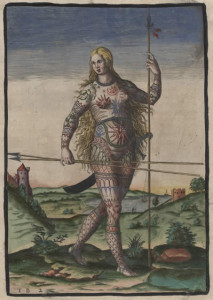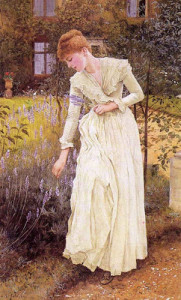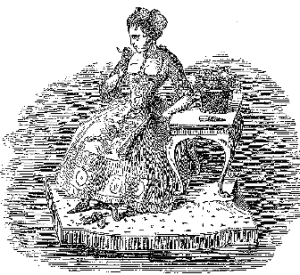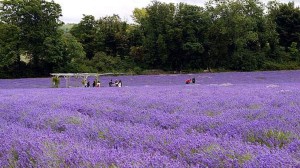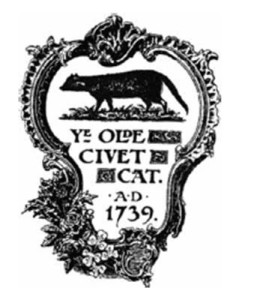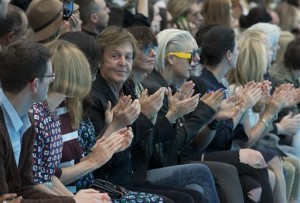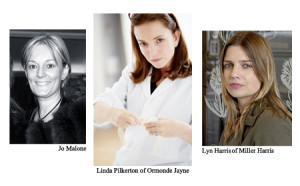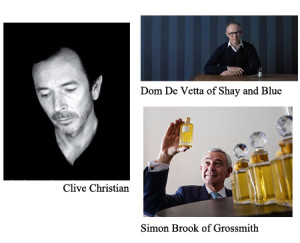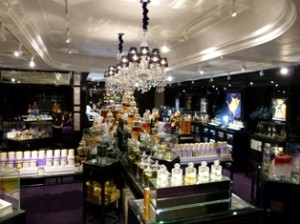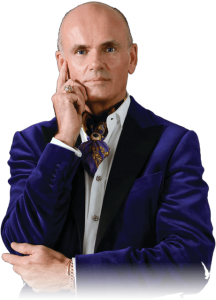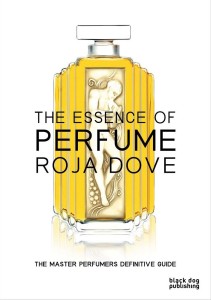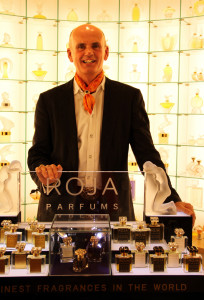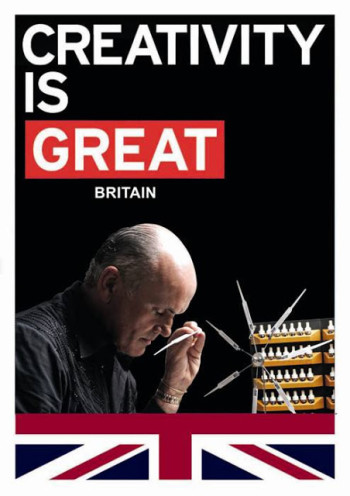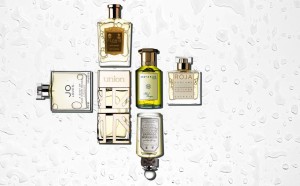Ancient Britons-Pictish Woman
It is interesting to think that a coat of arms, a symbol which is inseparable from British history owes its origin to perfumery, for part of the toilette of the ancient Britons was to paint their bodies with fats that were coloured using pigments that were often naturally scented to help protect them from adverse weather.
Royal Coat of Arms of Britian (1189-1198) Attributed to Henry II
Over time this decoration became the symbol of a freeman and separated him from a slave. Eventually freemen carried arms, so called as the designs were literally transferred from their bodies to their shields to show their allegiance to a particular leader – this is the origin of the family coat of arms.
Victorian Painter Edward Killingworth Johnson Woman in Lavender
The Roman conquest brought civilisation, scents, cosmetics and luxurious baths. The Romans introduced many fragrant plants, as only briar rose and lavender grew as scented natives, which they used in large quantities. In 'The Garden of Health' (1579) William Langham wrote of lavender ‘Boil, it in water, wet thy shirt in it, dry it again and wear it – this was the origin of lavender in every Englishman’s garden. Lavender was so associated with washing and cleanliness at this time a laundress was known as a ‘lavendre’.
Bad smells were believed to be harmful and so the tradition of carrying scent in pomanders became fashionable to protect against illness and plague. Henry V carried one made from solid gold at the Battle of Agincourt, filled with musk, rose, spices, and ambergris, which was the origin of the clove covered orange which reminded people of that golden orb stuffed with exotic spices.
An Elizabethan bejewelled perfume bottle taken from ‘The Cheapside Hoard London’s Lost Jewels (Source: The Essence of Perfume by Roja Dove)
Perfumes came into general use in England in 16th Century. It was during Elizabeth I's reign when perfumes were used on the skin for the first time for enjoyment. Alcohol as a solvent was not really known and so scents were often thick and somewhat oily by today’s standards. Rose often blended with musk, and it wasn't uncommon for sugar to be added to the formulae. Everything was perfumed, including leather to make gloves and jerkins, as well as necklaces and girdles which were made from a scented paste which was rolled into balls that were pierced and strung. Elizabethans employed full-time room fumigators and professional perfumers travelled the country to carry out the task for the wealthy. In 1573 Edward de Vere, Earl of Oxford, brought perfumed gloves from Italy which Queen Elizabeth I loved.
GW Septimus The Art of Perfumery 1891
Ambergris was quite widely used for this purpose, and one pair is in the Bodleian Library. Queen Elizabeth had shoes made of perfumed leather from Spain and the Earl of Oxford gave her a suede jerkin made from scented Spanish leather which she adored. Charles Piesse’s book The Art of Perfumery published in 1880 says peau d’Espagne (Spanish leather) was sold in Bond Street at one shilling per square inch. A totally ruinous sum today. She employed her own perfumer, Ralph Rabbard, and in 1584 spent £40 with another perfumer, John Kraunchwell and his wife, sellers of sweet waters. Today you could buy a house for that sum.
Surrey Lavender Field Photo BBC News
The first attempt for commercial distillation in Britain was at Mitcham in Surrey, in the 17th Century, which was the home of lavender. The world’s finest was produced there, and at Hitchin, Hertfordshire and Market Deeping, Lincolnshire. The earliest recorded formula for Lavender Water dates from 1615. There was no development in perfumery until the restoration of the monarchy with Charles II when Tuberose, Jasmine, and Frangipani all being popular.
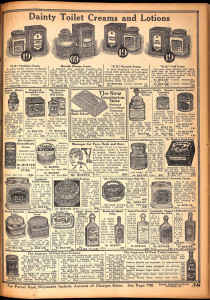
1915 advertisement for Markhams Gervase Skin and beauty Lotions (photo a Freckle in Time)
At around this time Markhams Gervase Skin Lotion appeared which is most likely the first commercial beauty preparation.
(Source: The Essence of Perfume by Roja Dove)
After the Plague people began to think about hygiene. Perfumed baths became the rage and ‘sweating houses’ opened and become as common as gin shops. The perfumer Charles Lillie, the first true English perfumer, started to perfume snuff, and in August 1711 held two hour lessons to teach people how to use it fashionably in his shop on the Strand. He was quickly joined by William Bayley who opened his perfumery on Long Acre before moving to Lockspur Street under the sign of, 'Ye Olde Civet Cat'.
Juan Floris of Floris Perfumes (source: Floris Perfumes)
1730 saw Juan Floris set up in Jermyn Street near the Court of St James's. By 1800 they supplied the Prince of Wales who gave them a Royal Warrant in 1812. The Floris Eau de Cologne was made for them by the Farina Brothers. This cologne is important as when Pierre-Francois-Pascal Guerlain came to England he spent time there and learnt the secret of their Eau de Cologne from them, which he launched in 1830 under the name Eau de Cologne Guerlain. This was put into the famous Golden Bee Bottle which was made as a wedding gift to Napoleon III and Empress Eugenie who granted him permission to call it Eau de Cologne Imperiale (The Empress' Cologne).
Vintage Yardley English Lavender Ad
In 1770 William Yardley set up a company with Thomas Beedal, By 1817 William Yardley made buckles and swords, but as wigs went out of fashion he started macerating Norfolk lavender in bears grease to stop balding, and by 1824, the year of his death, his lavender was famous and by the end of the century Yardley was the largest lavender manufacturers in the world. This was a far cry from the civet paste which could be purchased easily in Britain from chemists as early as the 17th century, and by the 18th century it was the essential must-have for any fashionable gentleman. It is interesting to think that civet, with its inherent faecal odour, was the scent of choice for the discerning gentleman. It is most likely the only material that was able to mask the rank stench of the pervasive and bestial emanations of London and those who inhabited it. Yardley's Lavender offered a much appreciated new freshness.
Paul McCartney, center with Chrissie Hynde, Anna Wintour (my guess), Rita Ora, Gwen Stefani (my guess) sit in the from row as they applaud the models during the Hunter Original Spring/Summer 2015 show at London Fashion Week in London, Saturday, Sept. 13, 2014. ALASTAIR GRANT — AP Photo
As a nation, we have always been known for our individuality and creativity. We have a worldwide reputation as leaders in fashion, art, music, technology, and sport to name but a few areas. It is therefore no surprise that we are seeing a renaissance of British creative perfumery. The timing is perfect as we are living in an age which demands individuality – British perfumery offers a great beacon of light in a world full of the darkness of mediocrity.
Jo Malone, Linda Pilkington of Ormonde Jayne and Lyn Harris of Miller Harris
It is essential to remember how Jo Malone revolutionised classic colognes – reinvented them for a new generation and the modern age. Her drive for creativity is now being expressed in her latest incarnation Jo Loves and the world wonders what she will do next. Whereas Linda Pilkington, who owns Ormonde Jayne, travels the world to find rare materials that have never been used in perfumery to give totally new olfactory effects. The third great lady of English perfumery is Lynn Harris with her elegant and refined creations which are sold under the name Miller Harris.
Clive Christian, Dom de Vetta of Shay and Blue and Simon Brook of Grossmith
The men were not to be left out – Clive Christian, best known as a kitchen designer, revived an old perfume house called Crown Perfumery which was founded in 1872 and renamed it Clive Christian launching the mens and womans versions of No. 1 under the slogan 'The World' s Most Expensive Perfume'. This was joined by another old English perfumery company, which had its heyday in Edwardian Britain, Grossmith, which was revived by Simon Brook who discovered he was a direct descendant of its founder. These sit with houses like Atkinson, 1799, who have just been revived with the launch of a range of beautifully crafted scents which play on their historical routes but in a slightly tongue-in-cheek way. In much the same way, the Cornish perfumery Penhaligon's have reinvented themselves, whilst remaining true to their routes with scents like Juniper Sling and Tralala, which in many ways make me think of the smart new comer, Shay and Blue by my friend Dom de Vetta.
Roja Dove Haute Parfumerie in Harrods (courtesy of Roja Dove)
Personally, given our rich scented heritage, I think it's incredibly exciting to see how British perfumes are emerging once again from our green and pleasant lands, becoming the deserved focus of global attention once again which I of course play my own part in. Having worked to create the world’s first Haute Parfumerie in Harrods, which has started a global trend, and having made bespoke perfumes for years, I launched Roja Parfums on July 2nd 2011. Many people make comment and opine about it – generally very kindly – but I have never spoken openly about my decision to launch a commercial brand. My mother once said how sad she was that with this generation of the family, the family name dies out. My parents both died, her words haunted me. I know I will never have children so I thought the way I can try to do something to potentially ensure the family name doesn't die out is by creating commercially available scents. Every creation and everything about it is extremely personal. Each has a small inscription on the back – A Fragrance by Roja Dove.
Roja Dove, Master Perfumer (courtesy of Roja Dove)
When I was a child we often used to holiday in Devon in the west of England. My mother had a soft-spot for it and loved to take us there. There was always an incredible feeling of excitement as we were about to set off. A frisson that was palpable. Today the only feeling that comes close is the frenetic hubbub that one experiences before a great train journey like that of the Orient Express – where there is still a strong element of glamour and expectation, fuelled by the knowledge that there isn't a later train and that the journey itself will be full of wonder – probably a once in a lifetimes experience.
The Essence of Perfume by Roja Dove 2014 (new edition)
My father would always insist on driving – the journey was full of ritual. The first was the scent and flavour of barley sugar from the travel tins of sweets that accompanied us – a strange idea from a bygone age when sweets were treats. En route we would break the journey for a picnic. We would usually stop and enter a small clearing in the woods. I wish I knew where that spot was – I wonder if it would be the same – my memory of it is that of a bucolic idyl. The reality might be far removed. The other ubiquitous bit of kit was the travel rug which was spread out before us and covered with the contents of the hamper. My over-riding memory was that of the smell of the little primus-stove which was filled with paraffin I think to be able to make fresh tea. My mother didn't like the idea or approve of tea from a thermos flask. The smell of the paraffin mingled with the scent of the countryside. It was raw, aggressive – omnipotent. It jarred. Maybe it is why I remember its odour so clearly so many years later. That said it also heralded treats. Everything about our holidays revolved around that idea – treats. The journey always seemed very long. We would play games in the car and sing certain songs that related to the holiday. I have no idea where these songs came from or who started the tradition, but they were as ubiquitous as Bing Crosby at Christmas.
I remember the change in topography – the hills and the red soil told me we had arrived in Devon with its promise of cream teas, clotted cream, and ice-cream. It seemed like paradise. On one journey I made my parents laugh as I became aware that Devonians were markedly shorter than Londoners. I said that I thought walking up and down the hills had worn their legs away. I thought what I said was profound and very clever – I didn't understand what was so funny about it.
Roja Dove at OsswaldNYC (courtesy of Osswald)
Eventually we would get out of the car and set about discovering the house. It smelt closed but wonderfully familiar – its scent a stark contrast to the smell of the openness of the sea with its tangy salt-odour. It looked over a small bay or cove. The sand was golden, the sea danced, seagulls cawed, and the sun always shone – and thus it will always be in my memory. My love of perfumery started with a goodnight kiss from my mother. I have been working for three years on a scent that will capture the idea of that goodnight kiss – it is almost there.
Creative Ambassador for Great Britain (Courtesy of Roja Dove)
The greatest accolade of my working career was when I was invited to number 10 Downing Street, the home of our government, and left having been made a Creative Ambassador for Great Britain. I was, and am, so unbelievably proud as everything I do is based around a fundamental passion and love for perfumery.
21st century British Perfumery Left Jo Loves,Top: Floris Middle Union, Shay and Blue, Bottom: Penhaligon's
Although it is not common knowledge, nor general opinion, it is important to understand and remember that Britain has a great heritage in perfumery, and is producing some of the most original and creative scents in the world as it enjoys its globally significant renaissance right now.
–Roja Dove, Master Perfumer, Historian, Author and Creative Ambassador for Great Britian
The Brit Pack: A term for young British actors in the 80s, including Daniel Day Lewis, Colin Firth, Miranda Richardson, Gary Oldham, Rupert Everett, and Tim Roth
Editor's Note: Last year, I awarded Roja Dove "Best Buzz (our Best of Scent 2013) The British Are Coming", when his uber luxe line Roja Parfums was introduced in the USA at Bergdorf Goodman and at OsswaldNYC. The buzz continues as new creative forces such as Liz Moores of Papillon Perfumes , Sara McCartney of 4160 Tuesdays and Michael and Simon Constantine aka the Gorilla Perfumers stormed our shores with innovative artisan olfactory concepts. For over a year I wanted to post an article that was devoted solely to British perfumery and appreciate that Roja Dove took time out of his busy schedule to do so. -Michelyn Camen, Editor in Chief
We have assembled a GREAT Britian draw for a US reader of 8 mystery samples of beautiful fragrances from Famous Houses (including a sample from the original Roja Parfums Unspoken ,2011), all mentioned in this article in Great Britian. To be eligible, please leave a comment with what you learned about the history of Great Britian. For your comment to count twice, please tweet your thoughts on this article adn some mad love to Roja @rojadove @fifthsensenyc (That is ÇaFleureBon, so we can see that you tweeted). If you are an EU reader and appreciated this informative article, please tweet Roja Dove as well, as he is on Twitter and will see it. Draw ends September 23, 2014
We announce the winners on our site and on our Facebook Page Like Cafleurebon and use our RSS option…or your dream prize wil be just spilled perfume

